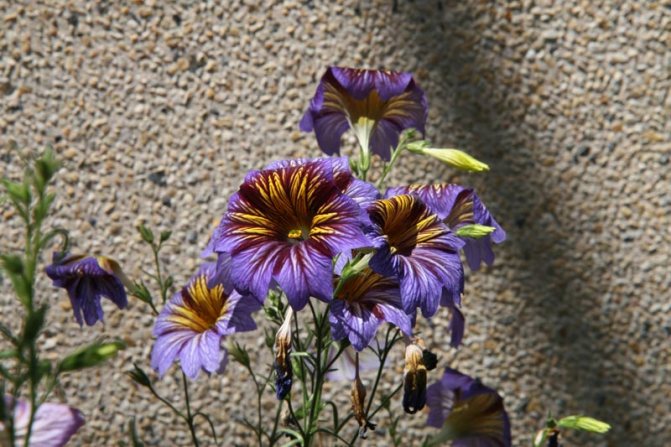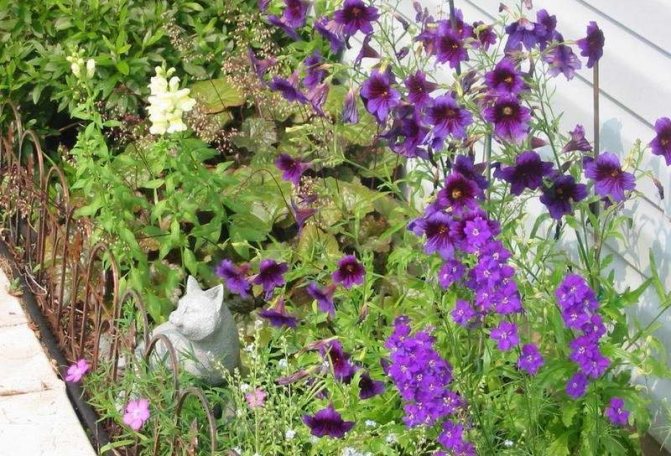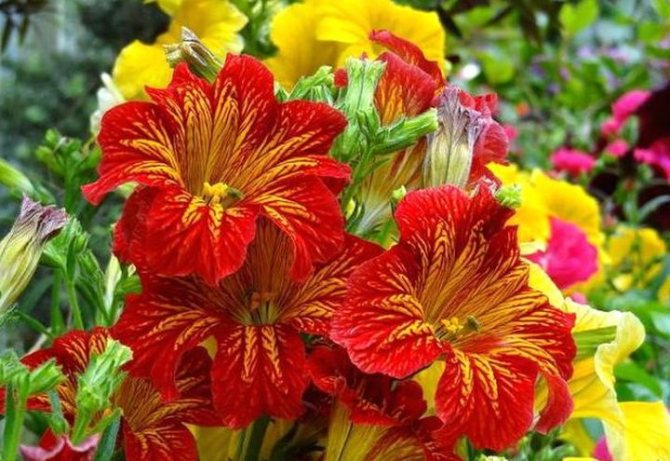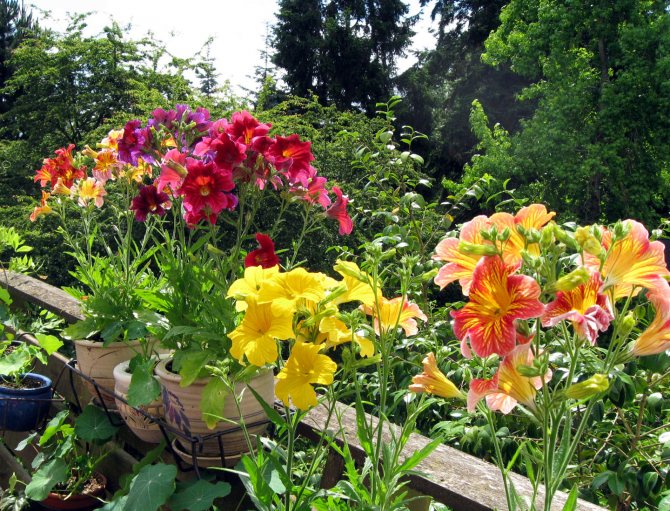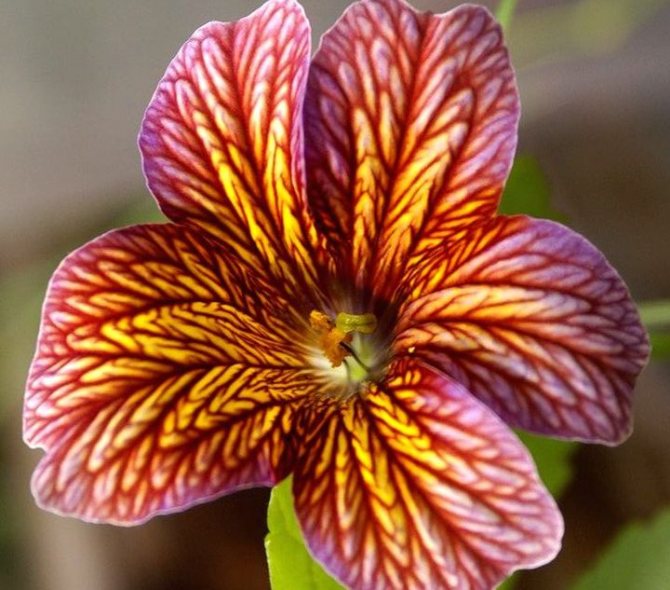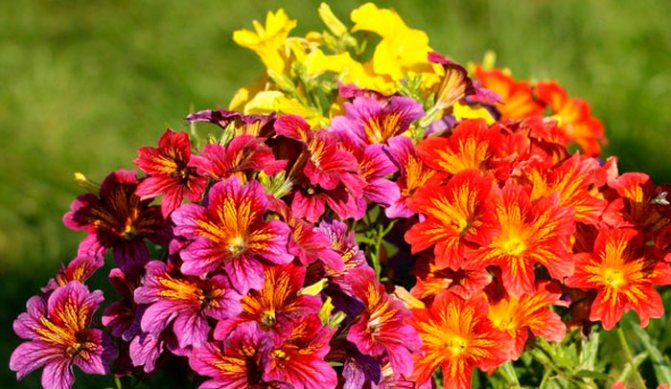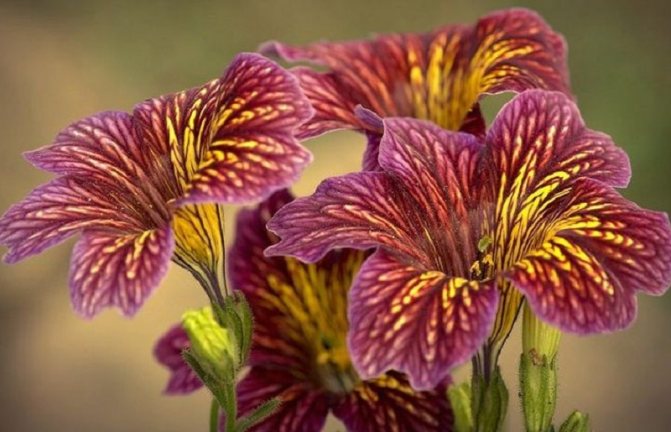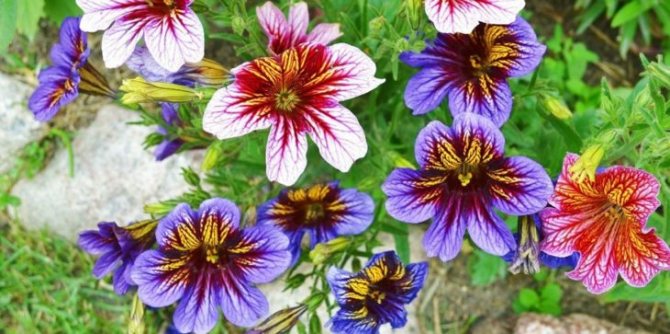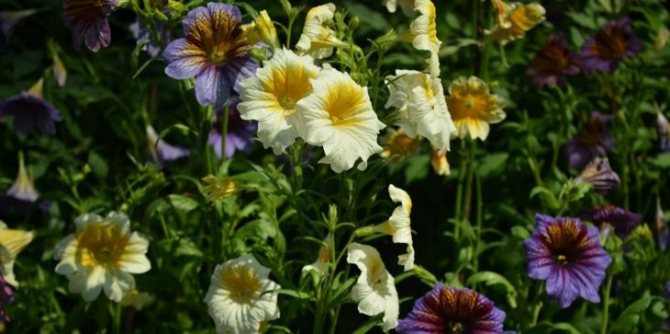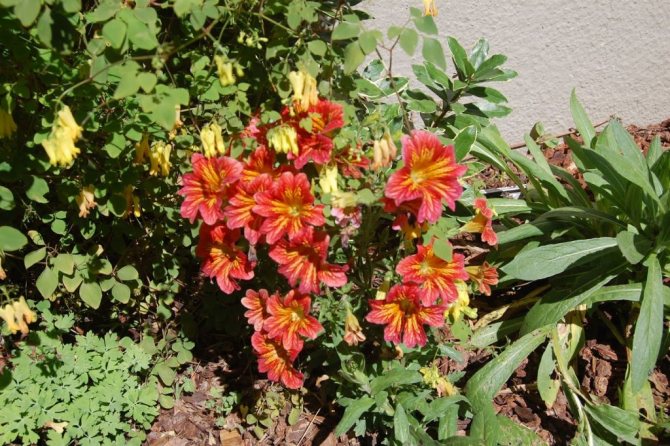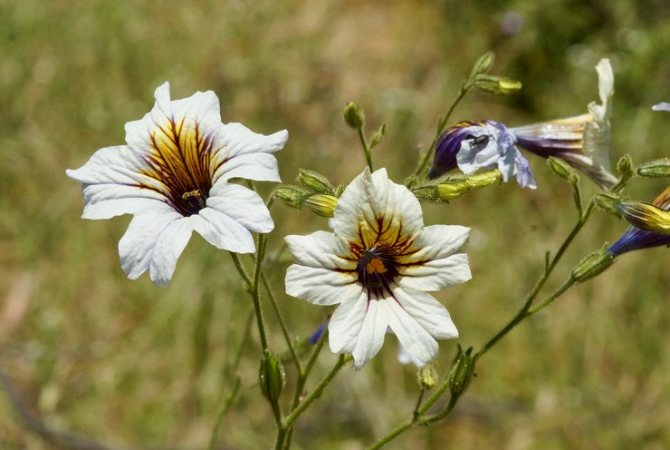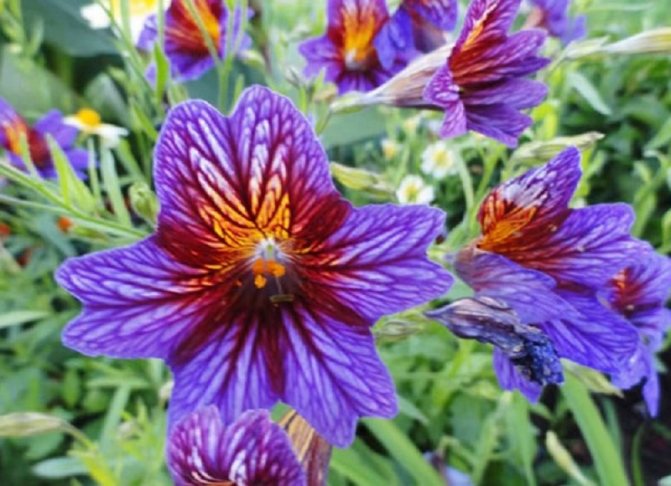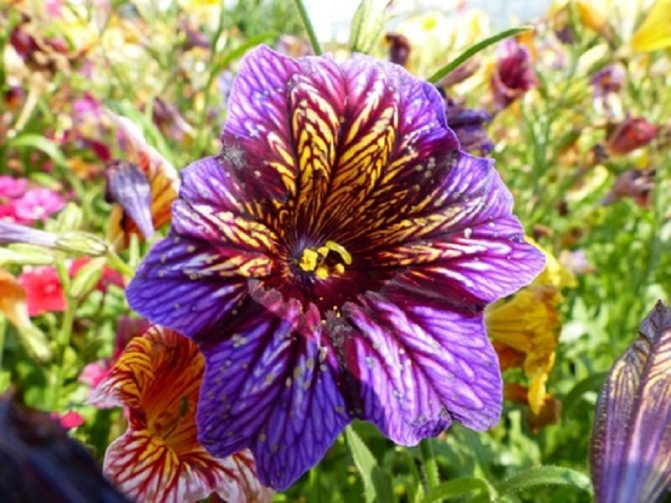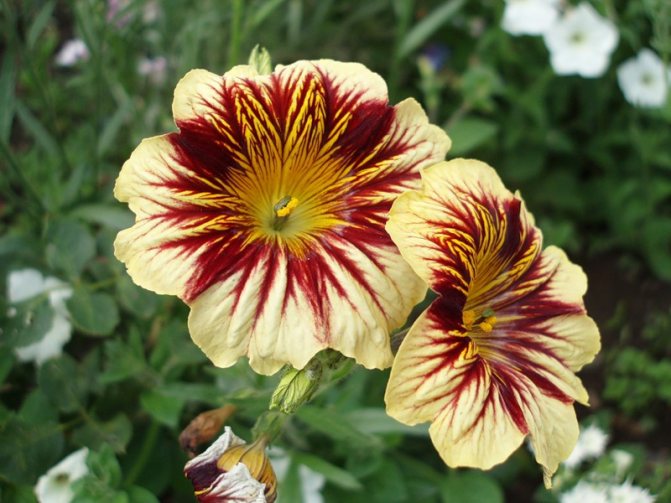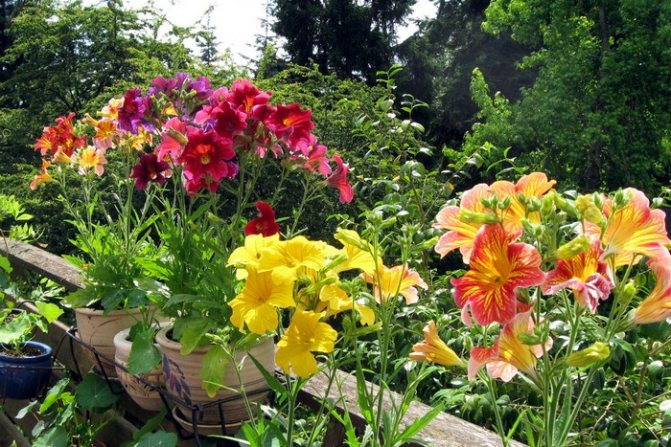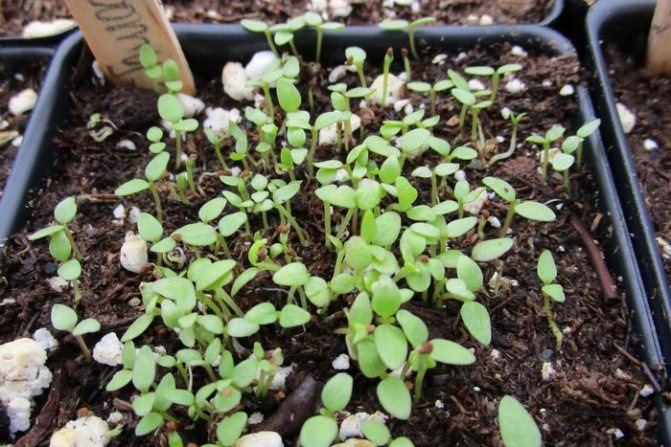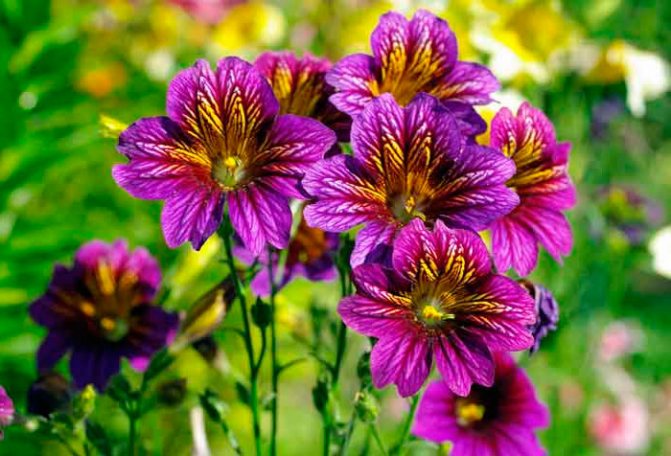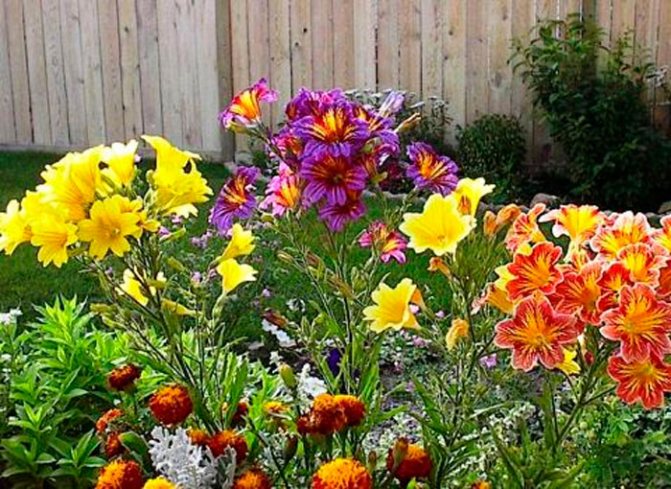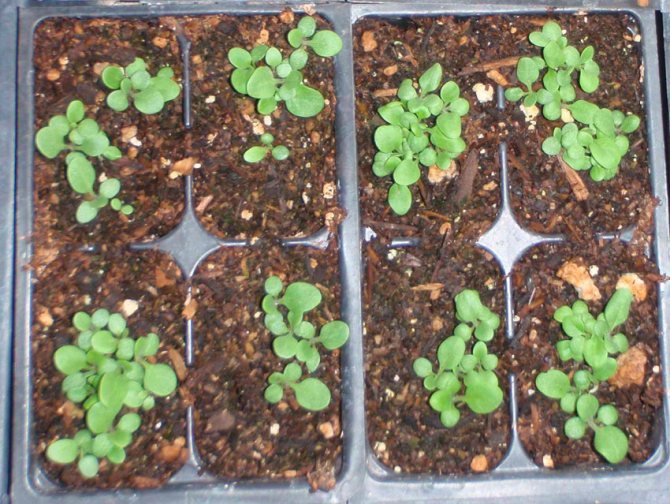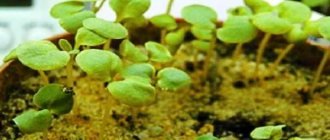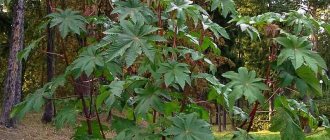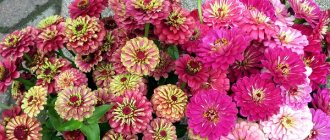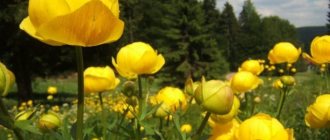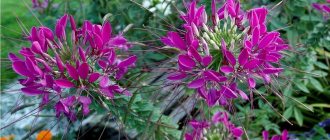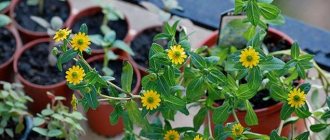Salpiglossis - a small genus consisting of two species belonging to the subfamily Cestrovye. The species grown in the garden is called - Salpiglossis notched (Salpiglossis sinuata), belongs to the Solanaceae family.
Salpiglossis has a bundle-type roots, due to its habitat on lands where water leaves rather quickly, the roots have thickenings that retain water. Shoots are rather thin, slightly sticky, branched at the top. Shoots have a huge drawback - they break easily. Leaves whole, broadly lanceolate, lower toothed, upper with a smooth edge, slightly wavy, covered with small sticky hairs.
The flowers are large, over 10 cm in diameter, growing on long petioles from the corners of the leaves. You do not need to stock up on seeds, hybrid varieties cost a penny.
The ‘Superbissima’ varieties are grown more often. There are also hybrids of the Bolero and Casino groups.
Types and varieties with photos
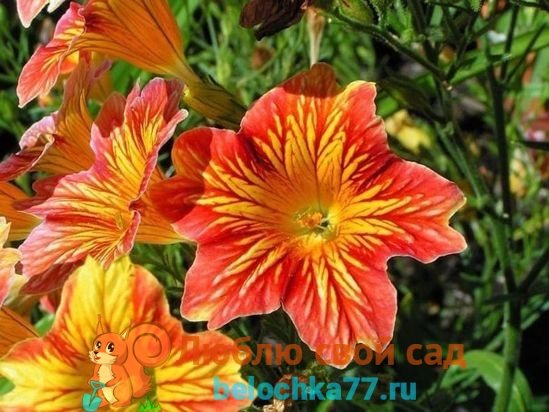
In the homeland of salpiglossis (Chile, Peru, Argentina), more than 20 one- and two-year (perennial) unique species are known. In our area, the most common are a variety of decorative forms of a fragrant champlevé (Salpiglossis sinuata). This plant was bred by breeders at the beginning of the 19th century. It is characteristic that for most of the available varieties, it is its progenitor.
Mixtures of flowers, hybrids are differentiated by height, degree of branching of the stem, peculiarities of adaptation to growing conditions. Their basic color is bright yellow, deep red, pale lilac, burgundy, brown. The most common types of salpiglossis are:
- Stunted with a maximum height of up to 40 cm and very lush inflorescences. Bright representatives of the variety Carnival, Kew-Blue, Nanum, Flamenco. Among them, one can especially highlight the compact flower mixtures Festival, which have a variety of colors of corollas and petals.
- Medium-sized ones grow up to 60 cm in height with weakly branching peduncles, flowers of different sizes. Here you can distinguish Bolero with a fairly stable stem, abundant flowering. The Casino Mix variety is also notable for its compactness. The exotic variety Ali Baba, bred by our compatriots, is also among the leaders of this group of flowers. A large-flowered mixture of Fireworks colors is considered a summer hit.
- Tall, reaching a growth of up to 1 m. Among them, Grandiflora stands out with branched peduncles, abundantly growing large flowers. The Superbissima variety is very popular with less pronounced branching of peduncles, rather large flowers, the edges of the petals and corolla of which are noticeably corrugated.
All these features make salpiglossis very appropriate in bouquets, flower compositions of landscape design. His variegated palette goes well with marigolds, petunias, salvias, chrysanthemums, cynaria in parks and garden plots. Diverse pipe-tongues will allow you to create spectacular compositions against the background of coniferous plantations. It is advisable to grow low dwarf flowers for decoration, verandas, attics, balconies.
Cochia - summer cypress - grown from seed
Features of salpiglossis
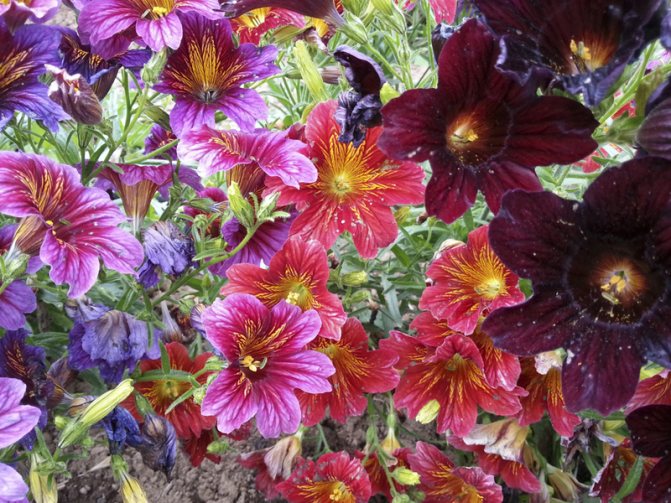

To date, only 1 species of this genus is cultivated by gardeners, namely: salpiglossis notched (Salpiglossis sinuata).Straight shoots can reach a height of 100 centimeters, they are branched and thin, and there are glandular sticky hairs on their surface. The upper leaf plates are narrow, entire and sessile, while the basal plates are notched-lobed, oblong and have petioles. The diameter of single graceful flowers is 5 centimeters, their color can be blue, yellow, brown, purple or cream, on the surface of the pharynx there is a marble pattern consisting of veins of dark and golden color. Flowering is observed in June-October. The shape of the velvety-shiny flowers is funnel-shaped, they have a five-lobed limb. The fruit is a two-nested oval-shaped capsule, inside which small seeds are located.
In the middle latitudes, salpiglossis is grown only as a biennial or annual.
How to grow seedlings from seeds at home


The relationship with petunia brings salpiglossis closer not only to the legend of its origin, but also to its cultivation. The technology of growing this marble flower allows for seedless and seedling planting methods.
When to sow for seedlings
Planting seeds in open ground is suitable for regions with a mild, warm climate. For the middle lane, it is more advisable to practice preliminary cultivation of seedlings. Indeed, with early sowing of seeds into the soil, the seedlings will be under the threat of freezing during spring frosts. And when sowing in a warm season, belated flowering and "leaving" of the bushes with all their beauty in the autumn-winter cold snap is not excluded.
Sowing seeds for seedlings is the optimal solution for the successful cultivation of outlandish tubules in a medium-climatic zone. Given their high sensitivity to frost, it is done in late March or early April. In this case, you can count on getting stronger shoots. And after a couple of months, stronger sprouts will appear, which the weather will no longer interfere with amicable rooting in the open field, timely flowering.
Preparation of land and seeds consists in the advance preparation of a loose nutrient substrate with a neutral / slightly acidic reaction. To do this, you can prepare a soil mixture from sod land, sand, ash in a ratio of 2: 1: 0.5. In order to reduce the acidity of the earth, it is allowed to add no more than 0.5 cups of peat per 1 kg of soil. Then the prepared mass is sterilized for up to 40 minutes by means of a water bath or frying in a hot oven.
The seeds do not require any special preparations before sowing. It is important to remember that they are not soaked or processed even with a weak solution of potassium permanganate. This is due to their inherent nature of high resistance to the effects of harmful microorganisms, fungal diseases.
Sowing and caring for seedlings
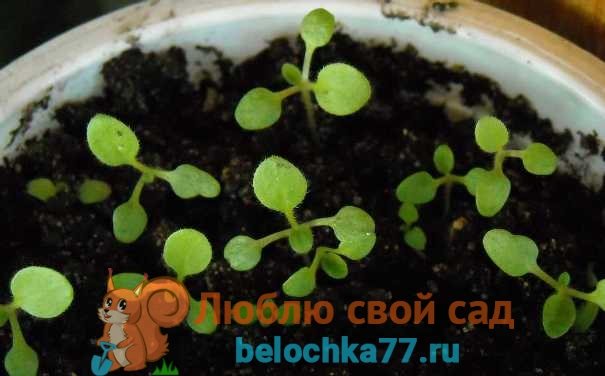

For growing seedlings, you can use small cups, peat tablets, plastic containers, small clay pots. Further work is to fill them with pre-prepared soil with moderate moisture from a spray bottle. Then 2-3 seeds should be carefully placed in each container, lightly pressing to the ground, and again sprayed with settled water. The predicted germination rate is up to 80%.
After that, containers with planted seeds are placed in a common pallet, covered with glass, transparent film. For successful germination, they are placed in a moderately lit, warm place with a temperature of up to +20 ° C. In order to avoid direct exposure to hot sunlight from above, the crops should be shaded with a sheet of paper.
After 15-20 days, with regular airing, moderate moisture, removal of condensate, the seeds will delight with their shoots. Starting from the first days of life of these sprouts, they will need to adapt to fresh air, supplement lighting with a phytolamp, and then completely remove the upper shelter.
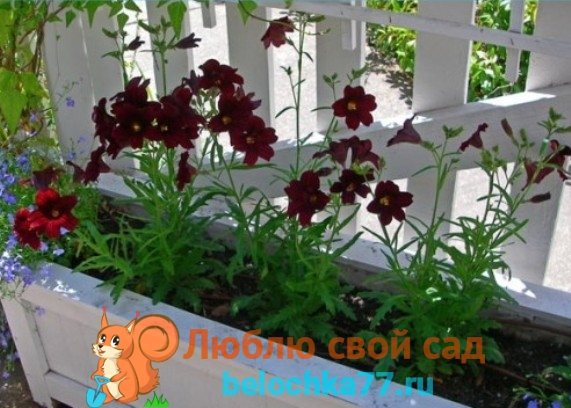

The appearance of the first pair of true leaves signals the onset of the picking time, that is, transplanting one seedling into a separate container. This process requires great care due to the increased vulnerability of the roots. It is best to do this together with a clod of earth before the active formation of the root system. This is where the advantages of small cups, pots, peat tablets are needed. After all, if there is one sprout out of several planted seeds, then a pick is not needed.
After a successful picking, the plants are strengthened as a whole. In order to avoid breaking the stem under its own weight, it is necessary to install supports for the stem of each plant. This practically coincides with an increase in the outside temperature, when the seedlings can already be hardened. Due to this, they will get stronger by the time they move to the site. In parallel with this, moderate watering is carried out without waterlogging, 2-3 times one-time pinching of the tops of salpiglossis.
Katarantus - growing from seeds
Photo gallery of views
Landing in open ground
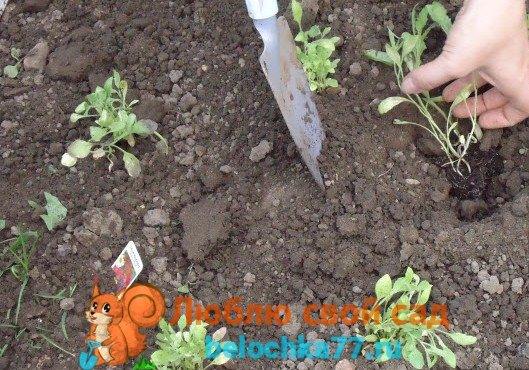

When choosing a planting site on the site, the requirements for looseness, nutritional value, moderate illumination and soil moisture are taken into account. After all, plants do not tolerate direct sunlight, and when even the top layer of the soil dries up, they doom them to poor development. In this case, transplanting from one to another site of the site can result in damage to the roots up to the death of the flower.
Relocation of matured, hardened seedlings into open ground is carried out from mid-May, when the threat of frost has passed with the onset of stable heat not lower than +10 ° C. 10-15 days before that, it is necessary to dig up the ground onto 1 bayonet of a shovel with the introduction of ash, dolomite flour. Clay soil is fed with sand, humus or peat. Before planting itself, the earth is dug up again.
Seedlings are placed at a distance between shoots up to 30 cm without destroying the existing clods of soil. As they grow, the bushes will grow and fill the original voids. The best way of transplanting is, as during a dive, transloading together with an earthen ball. Upon completion of planting, the plants are again strengthened with supports, watered with water heated by the sun, and mulched with compost from rotted garden herbs.
If these requirements are met, the flowering of rooted plants will begin in June and will last longer than those planted without seedlings.
Dahlia annual - growing from seeds
Description
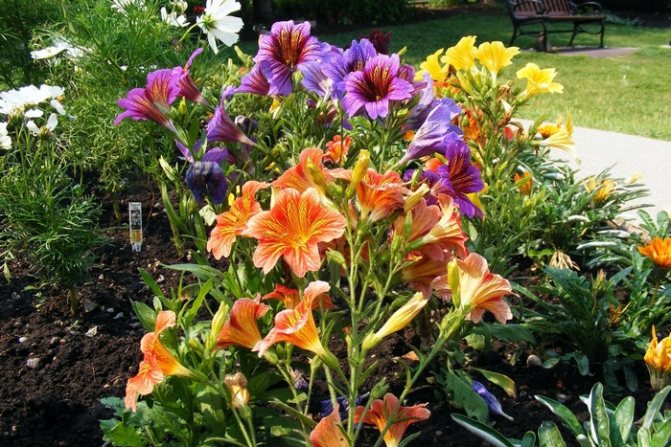

Salpiglossis notched is native to the Andean regions of Peru and Argentina. Height, hybrid varieties 40-70 cm tall. Flowering period, from July to frost. Flower color, pink, orange, yellow, blue, lavender, scarlet, purple, violet, burgundy. A place, only a sunny place. Given the fragility of the stems, there should be a place sheltered from strong winds.
Summer flower care


After adaptation of seedlings in the open field, summer care for them consists in performing such procedures as:
- Watering - one of the main conditions for growing salpinglossis. It should be regular according to the weather conditions. In summer, it is good to apply daily spraying of bushes. In the heat, the land around the plant does not dry out, and with increased moisture in the air, flooding with water with fanaticism is excluded. After moistening, loosening of the soil is required.
- Top dressing mineral fertilizers, organic matter is carried out 2 times a month. It is especially important to enrich the land during flowering (June-July). This activates the appearance of young buds, improves the decorative effect of inflorescences, the duration of flowering, makes the greens more juicy and dense.
- Topping central shoots also stimulates the processes of budding and flowering. Along with this, you should get rid of wilted, dried inflorescences.Such procedures help to achieve a more neat appearance of the bush, the formation of its splendor, and abundant flowering throughout the summer.
- Support creation fragile tall stems are necessary for protection from wind, mechanical damage. This helps to maintain the integrity of the growing flower bushes.
- Weed removal prevents the "drowning" of young plants and helps them to develop intensively, to delight with their colorful outlandish tubes.
Landing, choosing a place
The best option is a well-protected, bright place, with fertile, well-fertilized soil (it is enough to dig up ordinary garden soil with a small amount of ash, sand, peat and humus). The soil should be neutral or slightly acidic.
The plant can grow in partial shade, but the flowering will be much weaker.
The plant works well in container culture, in winter it can be grown as a room indoors. As a soil, either universal soil for flowering plants or a mixture of flower soil with coarse (quartz, river) sand is used - it is important that the soil for planting is loose, nutritious.
For winter cultivation, you need a light, preferably slightly cool room (but not lower than 16 degrees).
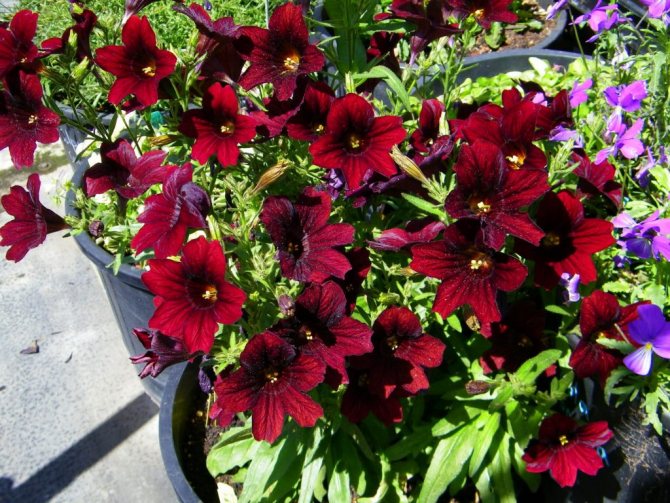

Diseases and pests
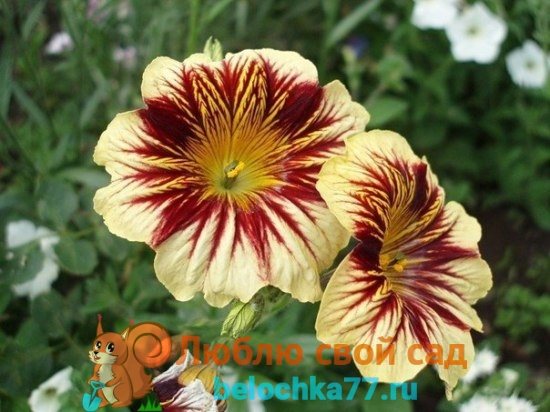

The problem of the fight for the health of salpiglossis is most often encountered in hot and rainy periods. Excessive or insufficient watering can also be provocateurs of diseases, intensification of attacks of harmful insects.
Its main enemies are fungal diseases (late blight, powdery mildew, fusarium), pests (aphids, thrips, spider mites). When infected with a fungus, the leaves and stem change their color, the plant rots and completely dies. For the purpose of prevention, even before planting, the soil is treated with a fungicide. However, when infected with this disease, the bush is removed and destroyed.
To get rid of pests, strong infusions of bitter wormwood, garlic, celandine are suitable. A solution of high concentration laundry soap also helps. The use of insecticidal agents is widely practiced.
Purslane - growing from seeds
Use in landscape design
Salpiglossis has proven itself well in group plantings (rabatki, flower beds). It can be used to fill the voids among perennials. However, you should not plant the pipe-tongue at large distances - its bright colors merge into one spot, and the opportunity to appreciate all the beauty of the flowers is lost.
In group plantings, salpiglossis can be successfully emphasized with ornamental deciduous plants with a silvery leaf color (cypress santolina, Schmidt's wormwood, etc.). Purple lobularia and blue lobelia also highlight its beauty.
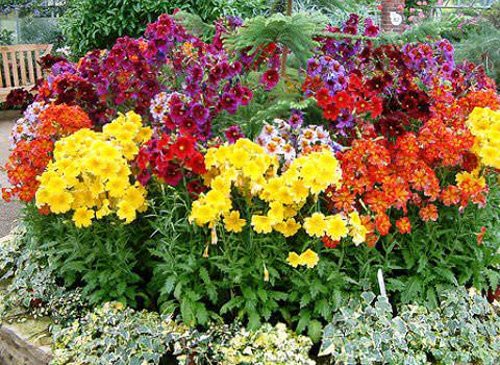

The beauty of salpiglossis is emphasized by ornamental plants
Dwarf varieties can be grown as a pot culture for decorating balconies, attics, verandas. Cut salpiglossis retain their freshness in bouquets for a long time.
How to collect your seeds
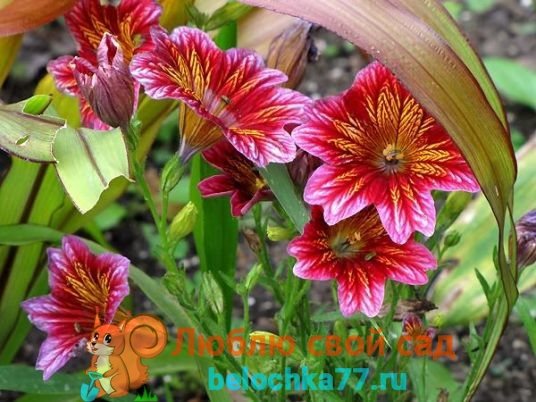

It is possible to determine varieties for future plantings even with the regular removal of wilted inflorescences. A few of the largest remnants of dried flowers are left on the bush. In their place, fruits are formed in the form of oval two-nested bolls. Each of them can collect up to 6,000 small seeds. When stored in a cool dry place, you are provided with full-fledged planting material for at least 4 years.
Seeds not harvested on time lead to self-sowing, which, under favorable conditions, can lead to their subsequent germination.
Difficulties
The plant is not capricious in general, but like any guest from warm countries, it does not have very strong immunity and can be affected by diseases and pests:
- Fungal diseases. If you find spots on the stems or leaves, all affected areas should be removed, and the plants should be treated with a fungicide. If the plant is severely affected, it is better to completely destroy it so as not to risk other specimens.Prevention: planting seeds in sterilized soil, treating seedlings with a fungicide.
- Aphid. To get rid of it, there are a number of folk remedies, as well as insecticides.
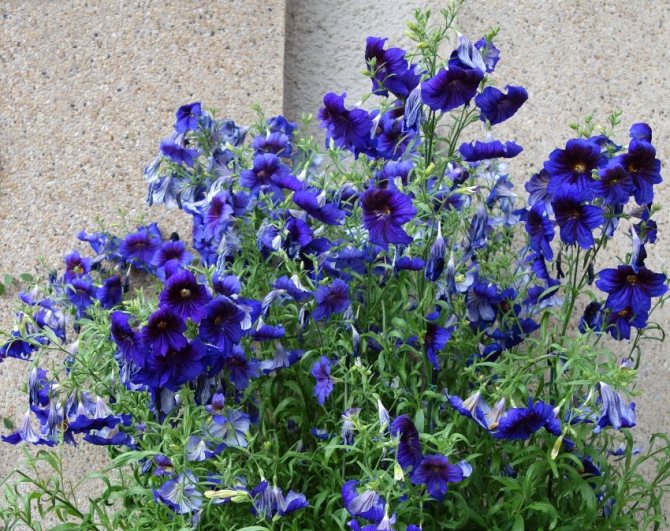

Fantastic 'Kew Blue'
Care during and after flowering
The gramophone buds adorn the bushes of the South American plant for three to four months. During flowering, the bushes are regularly fed: the fertilizers should contain more potassium and phosphorus, the nitrogen level is lowered.
It is advisable to immediately remove the buds that have faded from the bush so that the plant does not give nutrients to the dried elements. Plentiful watering according to the rules is no less important, especially in dry summers. Moisten the substrate early in the morning or late in the evening.
On a note! The flowering period of Salpiglossis grown through seedlings comes in the second or third decade of June, and lasts for the onset of frost. If the hostess sowed the seeds directly into the ground, then the buds appear later: approximately, in July.
How to care
Salpiglossis will actively grow and bloom in an area that is well lit by sunlight and at the same time protected from the wind. Since the plant is thin and has a long stem, it can break in strong winds. So tall crops must be tied up using a special stable support.
The crop in question requires regular and good watering. At the same time, make sure that the top layer of the earth has time to dry out between waterings. Then the root system will feel as comfortable as possible. Complete drought is unacceptable, as this will lead to the death of the roots. It is also worth learning how to plant Ranunculus root. The flower reacts positively to spraying with green leaves. This is especially true during extreme heat.
To give the bush a lush look, it is necessary to remove wilted flowers in time and pinch the central shoots. (But what fast-growing shrubs for hedges look like can be seen in this video) Top dressing should be done with the help of mineral fertilizers. It is very important to bring them in during the flowering period. This will enhance the formation of young buds, and also make the bush thick and juicy.
It is necessary to apply mineral fertilizers several times throughout the season. This will give the bush a decorative look and prolong flowering.
Salpiglossis is rarely affected by pests and diseases. Even before planting, the seeds do not need to be processed and prepared. When fungal or putrefactive diseases have formed, the affected areas must be removed. Sometimes the defeat is so serious that the entire bush has to be uprooted. (And here you can see in the photo what the Forsythia shrub looks like) If the plant is attacked by aphids, then it can be treated with insecticides.
Autumn care
Salpiglossis is an annual plant: in temperate climates, the delicate root system does not tolerate frost well, and the thermophilic flower does not hibernate in the soil. Some amateur flower growers try to preserve the plant until next spring, dig up a bush in the fall, transplant it into a flowerpot and keep the flower indoors. Some specimens take root, but often the experiment with the transformation of Salpiglossis into a perennial ends in failure. If the plant has survived the winter in an apartment, then the re-planting of the bush in the spring on the site is carried out only after good heating of the soil and air, when there is no risk of recurrent frosts.
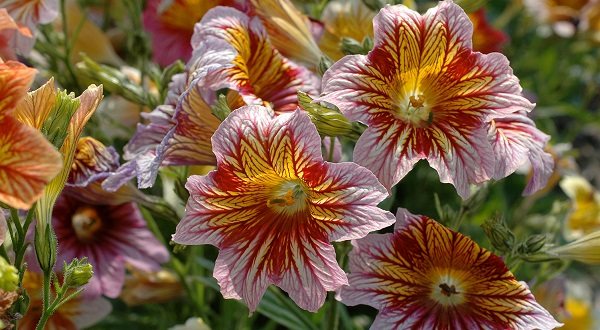

Testimonials
- Irina, 32 years old: “I planted salpiglossis in the flowerbed 2 years ago. I grew it together with my other plants, including asters, chrysanthemum. I want to say that the culture is blooming just incredibly beautiful. Moreover, it begins in the summer and lasts until the first frost. Taking care of the plant is quite easy, even my 7-year-old daughter does a great job with it. "
- Karina, 27 years old: “Salpiglossis is a plant that pleases me and others with bright and long flowering for a long time. I don't plant anything else in my flower bed, since salpiglossis is presented in several varieties. Of course, proper attention should be paid to watering. The plant does not like drought. If this moment is missed, the flower will die. I know this from my own experience. "
- Svetlana, 46 years old: “I was given the seeds of salpiglossis a year ago. I don't really like growing seedlings. But I still had land after I transplanted houseplants, and I remembered the seeds I had donated. I planted them in a spacious pot and covered them with glass. When the seedlings got stronger, I transplanted them to the flower bed. Honestly, I did not believe that such fragile plants could survive, but they not only survived, but also gave my flower bed bright colors. The flowers were white, lilac and light lilac. "
If you want to create an original and attractive flower bed, then be sure to purchase the seeds of a culture such as salpiglossis. This is a very interesting and colorful plant that is easy to care for and goes well with other flowering and green crops.
3.Fertilizer
Feed salpiglossis every two weeks during the period of active growth and it will surely thank you with lush and long flowering.
3.1 Watering
Water the plants so that the soil dries up to half the depth before each subsequent watering. Salpiglossis is more likely to survive a short drought than even a small bay.
3.2 Transplant
Salpiglossis is often grown as an annual plant and does not need replanting.
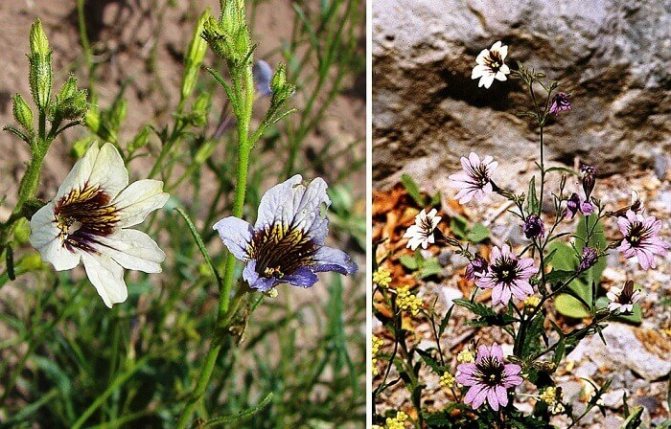

3.3 Spraying
There are no special requirements. Can be sprayed in the morning if the air becomes too dry. Provide a location with good air circulation.
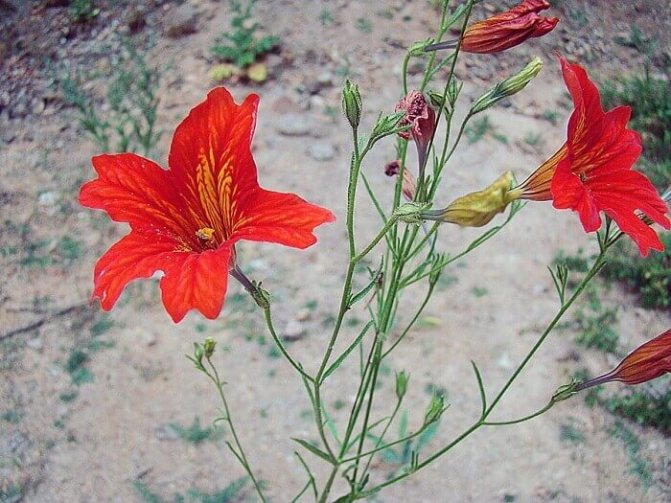

3.4 Purpose
Depending on the time of sowing the seeds, you can get a beautifully flowering plant at any time of the year. Perfect for landscaping balconies, loggias and terraces. Salpiglossis flowers are used for cutting and do not lose their attractive appearance in water for a long time.
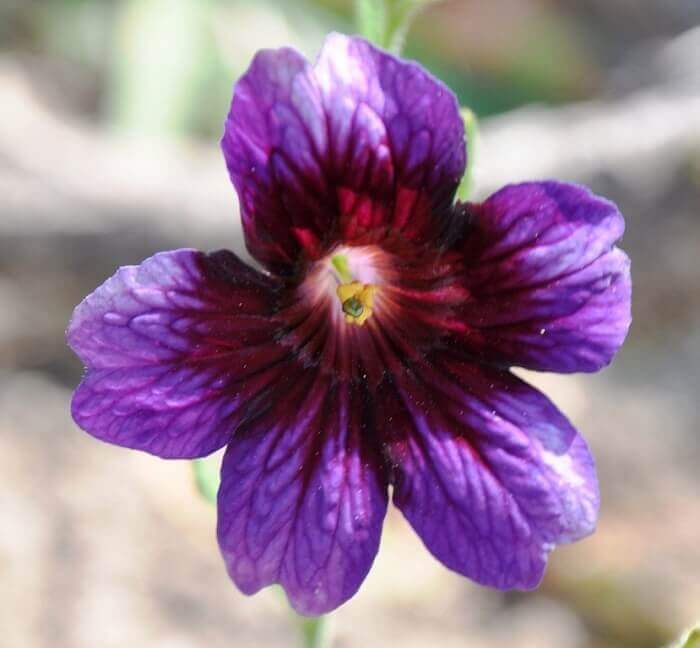

Flower reproduction methods
The cultivation of a salpiglossis flower is carried out in two ways. These include:
- seedling method;
- planting seeds in open ground.
Seedling method
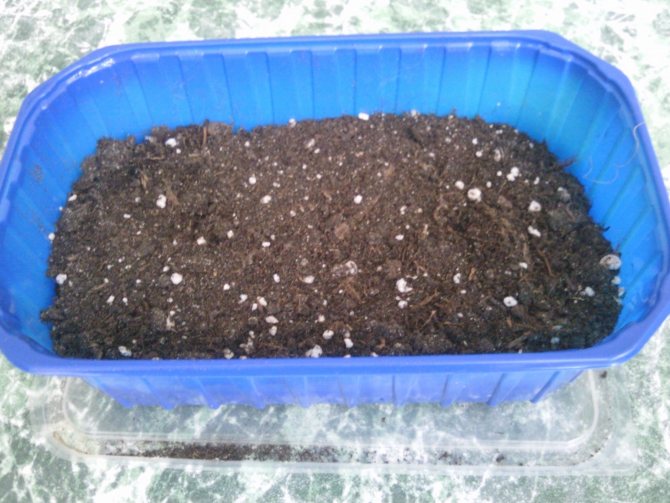

In order for the flowers to bloom as early as possible, seedlings are first grown. Growing salpiglossis from seeds at home usually begins in March. Pre-growers purchase soil for flowering plants and planting material in a specialized store. The Superbissima variety is best suited for this procedure. The plant does not tolerate a pick, therefore, the seeds are planted as rarely as possible or immediately in separate pots.
A drainage layer of expanded clay or fine gravel is laid out at the bottom of the selected container. Then the fertile soil is poured and moistened abundantly. The seeds are carefully spread over the soil surface and covered with a thin layer of light soil. It is moistened again with a spray bottle. The container is covered with plastic wrap with small holes for ventilation. Landings are removed in a bright and warm place.
The air temperature should be within 20 ° C. As soon as the first shoots appear, the film is removed. If you still need a pick, then it should be done very carefully., being careful not to damage the weak roots.
When a positive air temperature is established, the seedlings are hardened. To do this, they take it out for a day on a loggia or a glazed balcony. As soon as the soil in the garden area warms up well, the seedlings are planted in a permanent place.
Planting seeds in open ground
Planting seeds is carried out directly in open ground, especially in areas with a warm climate. Sowing seeds is done both in spring and autumn. Autumn plantings give more efficient germination and early flowering. In the spring, flower growers begin to plant seeds in late April or early May.The selected place on the site is dug up and, if necessary, lime and humus are introduced to reduce the acidity of the soil. In the prepared area, shallow grooves are made and seeds are laid in them.
Features of growing meadow cornflower
Plantings moisturize abundantly, the best way to do this is with a spray bottleso that the planting material does not get deep into the soil. For the first time, the beds can be covered with plastic wrap. As soon as the sprouts get a little stronger, they are thinned out, leaving a distance of at least 20 cm between them. Autumn plantings for the winter must be covered with dry leaves or spruce branches.
Real miracle
Salpiglossis is a plant belonging to the Solanaceae genus. He has another name - the pipe-tongue, which he received for the shape of the corolla of the flower, resembling a tongue rolled into a tube.
In the photo, salpiglossis attract with their uniqueness. There are about twenty species in the genus, including annuals, perennials, herbaceous plants, native to Argentina, Chile and Peru. All of them are unusual and beautiful.
In our country, a fragrant and notched type of plants is grown. The unusual bright iridescent color allows the plant to be used in combination with chrysanthemums, in group plantings in small flower beds.
Looking through photos of salpiglossis, connoisseurs of unusual and bright plants pay attention to the lush inflorescences that bloom from June and delight until the very frost. The funnel-shaped flowers are decorated with a variety of shades - from white to deep purple.
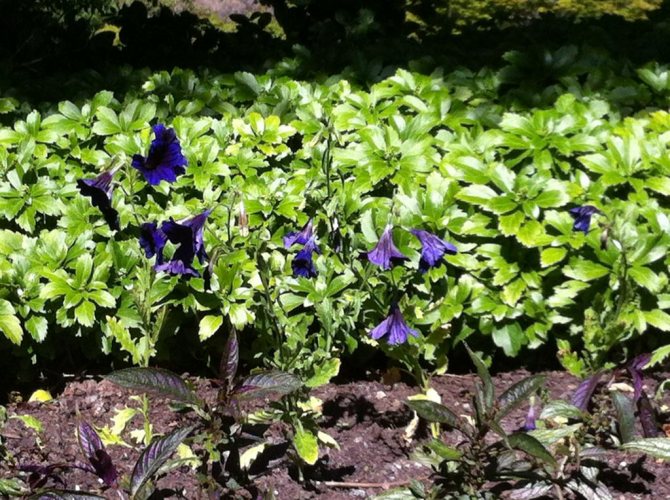

Mulching, loosening
Simple activities have a positive effect on Salpiglossis:
- creating a layer of mulch. Wood sawdust, chopped straw, peat are natural materials to protect the soil from drying out. Mulching retains moisture in the soil, even during dry months. Weeds grow worse under a layer of mulch. To protect plants in summer, it is enough to pour any kind of natural material with a layer of about 1 cm;
- loosening the soil. Another useful procedure for normalizing the aeration process. They loosen the soil to a depth of several centimeters so as not to damage the roots. After loosening the moistened and slightly dried soil, add mulch.
Popular varieties
Although there are about 20 species of salpiglossis in nature, only Salpiglossis is used for breeding. Large, medium and dwarf varieties are already formed from it.
Kew Blue
Decorative variety. The height of the bushes does not exceed 30cm. Flowers of various colors: marble, bright pink, purple, purple with golden veins. Well suited for greenhouses and landscaping.
Superbissima
Selection variety. The bushes reach 60cm in height and end in large, varied buds.
Bolero
Lush stems are abundantly covered with greenery and grow up to 60cm. The inflorescences are predominantly pink with crimson patterns. The variety thrives in sun and shade. Abundant flowering.
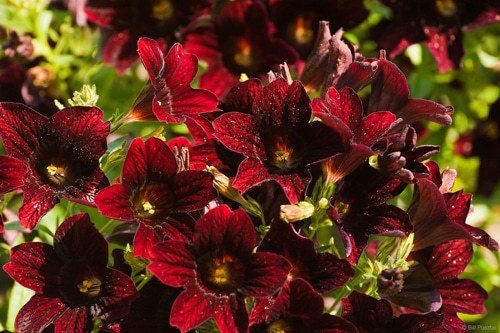

Fireworks
Designer variety for decorating landscapes and bouquets. The lush stems grow up to 65cm in height, and end in bright lilac, purple, red or pink buds with a diameter of about 6cm.
Large-flowered
The variety is a giant. Bushes of high-rise buildings about a meter with branched stems and large buds of various colors, any floral group will decorate its presence.


